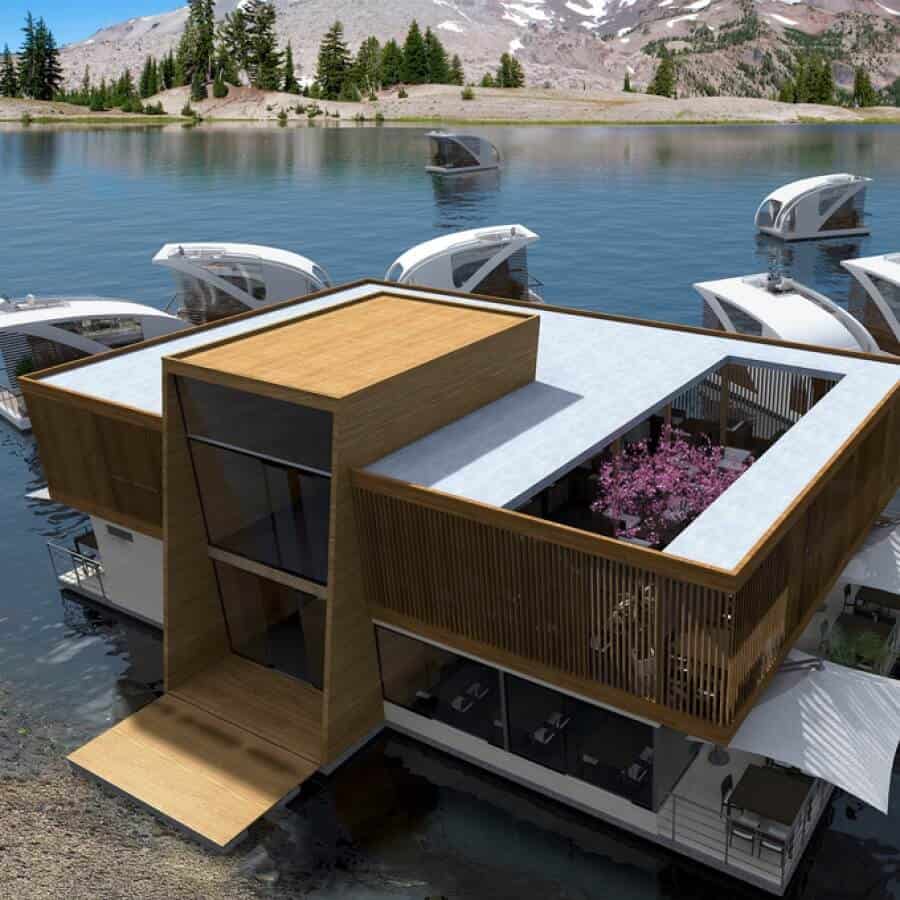Have you ever heard of someone who designs the interiors of airplanes? If the answer is no, you are reading the right article. She won so many awards that is impossible to put them in a paragraph, and she keeps moving the boundaries of modern architecture and interior design. Svetlana Mojic (34), architect and interior designer, is one of the rare experts in Europe who is specialized in boat and airplane furnishing. Her innovative catamaran solution brought her the first award of Creative Business Cup Serbia last year. And she had already become widely recognized after receiving The International Yacht & Aviation Award 2014, for the best interior design of a private jet, a Boeing 787 VIP Dreamliner. Her high-end ideas include floating hotels and yachts that change their interiors according to the surroundings. Today, Svetlana is the proud owner of her own studio, and she uses every chance to travel the world searching for inspiration that will bring her to new, timeless solutions.
Dear Svetlana, since so far you have designed everything from luxurious residences to hi-tech boats and yachts to cutting edge styles in the airplane industry, can you tell us what you and your team are working on at the moment?
We started the year in great style. At the moment, we are designing a private house, a marvelous hotel, and a cafe. Besides this, we are also working on the interior design of a big ship, which we are very excited about. All these designs are being done for different clients, each of whom prefers a different style. This situation can be challenging, yet really fun at the same time.

Photo: Salt & Water
You are one of the rare interior designers in Europe who designs luxury airplanes and yachts, and you are one of a kind in Serbia. The impression is that you do not have many competitors in your own country – but what is the situation like in the rest of the world? How hard it is to beat the competition in this unique branch of the design industry?
Luxury design is a specific field which differentiates one part of the world from another. Thankfully, so far I have had the pleasure of working with international partners. For the interior design of a private Boeing 787 VIP Dreamliner, my team received the prestigious International Yacht & Aviation Award 2014. This was a big challenge considering that our competition included Lufthansa professionals. Yet, we were the ones who came home with the prize. This was a true honor and a definite confirmation of our quality. Working in this industry can be somewhat challenging in terms of finding the right audience. This problem applies to all companies, no matter how big or small they are. In other words, it still remains a question how many wealthy people are reached by our industry. Nevertheless, I strongly believe that an innovative design can help you overcome all obstacles, and I can see my team making it happen.
You have a Bachelor’s Degree in Architecture and two master’s degrees. One of them is in the field of Yacht Design and Construction, and you earned it while studying in Venice. Tell us more about how you managed to win a scholarship for professional studies regarding the interior design of yachts? What were you impressed by the most, while learning from Italian experts?
It was during my last year of studies that I realized what I wanted to specialize in. So, first I went to Sweden to attend a summer school of yacht design (more about that later). Afterwards, I won a scholarship for Yacht Design and the Construction Master’s Programme at Istituto Europeo di Design in Venice. The project that gained me this opportunity was a yacht concept by the name of Eco Chameleon. This vessel was designed as an innovative yacht with big glass panels that change the appearance of the interior in response to the surroundings. Thanks to my experience in sailing, I was aware from the beginning that no matter how big a yacht is, when it is in the middle of the sea, far away from a coast, it will always seem small.Yet, thanks to an adaptable design, I was able to get hundreds of variations in the same space – which would not be possible without new technologies.
In Italy, the whole concept of studying is different. There were just 8 of us students, so the professors got to know us really well. Thus, they were able to understand our strengths and specialties, as well as the way we individually worked.

Attending the yacht design summer school at the University of Gothenburg was crucial for your career. You had the privilege of learning from the greatest living expert in the field of the theory of designing ships and sailing boats, Mr. Lars Larson. Tell us more about this experience.
Lars Larson is the world’s greatest living theoretician in the field of yacht design. He wrote the most important piece of literature in that field, which is studied all around the world. In 2006 I attended his yacht design summer school at the University of Gothenburg, where he works as a professor. This was an amazing experience. When summer school ended it was clear to me which path I wanted to pursue in my career.
It is not easy starting your own company – today after more than five years you are the proud owner of Salt & Water design studio. What steps were the most difficult in the beginning, and tell us about how you got your first big client?
When I moved to Italy in 2010 to attend the master’s program, I already had some professional experience as a yacht interior designer, so I continued to work in Italian studios. Basically, I was continuously working while studying. That was a really exciting time. After two years, I realized that the best choice for me would be to get back to Serbia, open my own studio, and start working for foreign clients. I already had a lot of contacts, and my existing clients knew they could rely on me, so that was a fair beginning.
Where do you find inspiration for your interior designs?
I look for inspiration everywhere. I truly believe that interior and outer spaces should complement each other, to be entirely consistent. This is the model I tend to apply in all my projects. Besides that, I am taking care that all of us in the studio keep up with modern technologies, new materials, and design trends.
Among the many stunning projects the world is talking about, you also have designed the impressive Floating Hotel at Zvornik Lake. Can you tell us more about that – is the project up and running, has it been completed already, and could this be the future of rural holidays in Serbia?
Although our Floating Hotel was indeed designed for the needs of Zvornik Lake, this municipality is no longer considered a designated location. Later we developed and redesigned the project, but our main goal is to provide a compellingly innovative hospitality project for rural areas, preferably in Serbia. Having this type of project built at a previously undevelopoed location can expand the tourist potential of the region, while separable catamaran apartments allow guests to reach the undisturbed places in the natural environment. Thus, we believe that catamaran apartments can be used as individual units as well. With that in mind, we were approached by many international clients interested in this project, whether for private or commercial use. The start of construction is planned for this summer, and we hope we’ll get to see the real-life catamarans by the end of the year.

The world has, surely, heard of you since you received the International Yacht & Aviation Award 2014 for the interior design of a Boeing 787 VIP. You won by beating many other teams, including the previously mentioned Lufthansa designers. Afterwards you were commissioned for a few more projects featuring airplanes – can you tell our readers more about the procedure of designing the interior of an aircraft?
No matter what type of project we are working on, we always tend to meet three main criteria: functionality, originality, and supreme design. I always like to point out that a design is a two-way process. It doesn’t depend solely on us, but also in the way we communicate with our clients. Therefore, one might say that excellent communication is the key element of a great design.
Is there any specific trend in designing the interiors of yachts that clients ask for today? Can you give us some examples of what details are most sought after at the moment?
In our studio, we aim to create designs that are timeless. Buying a yacht is a serious investment, a once in a lifetime kind of thing, which is why I avoid relying on popular trends that will be considered outdated in no more than ten years. We love using materials in natural colors, different textures, and to play with light.
How many countries have you visited in the last six months, and what is your next stop?
November last year was an exciting month. First, I visited Metstrade and the Global Superyacht Forum in Amsterdam. These are annual events, each considered “a place to be” for everybody in the industry. The experience was amazing. I’ve learned a lot of cool new things, and I can’t wait to go back next year. A few days later, I visited Copenhagen, Denmark. There I had the opportunity to present the Catamaran Apartment project in front of an international audience at the Creative Business Cup event. Before all that, I was in Hungary acting as a sailing judge on an international regatta. This is something that keeps me grounded and healthier, and that I have enjoyed doing for many years now. My stay in New York last October helped me charge my batteries and collect fresh ideas. In April, three of us from the studio are going to Milan Design Week, the greatest event in the field of interior design.
Support us!
All your donations will be used to pay the magazine’s journalists and to support the ongoing costs of maintaining the site.
Share this post
Interested in co-operating with us?
We are open to co-operation from writers and businesses alike. You can reach us on our email at cooperations@youthtimemag.com/magazine@youthtimemag.com and we will get back to you as quick as we can.










